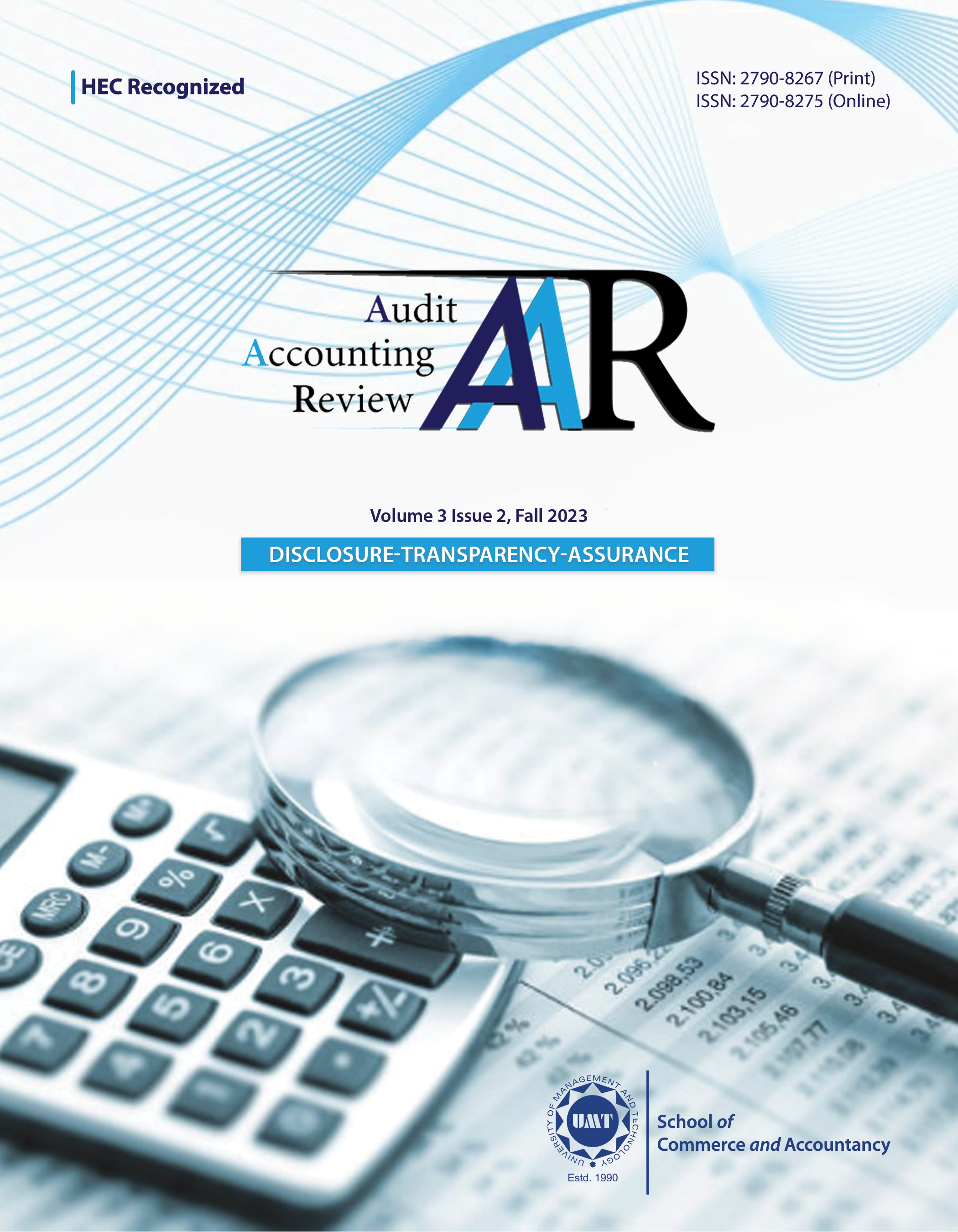Liquidity Creation and its Impact on Economic Growth: Moderating Role of Firm Size
Abstract
 Abstract Views: 0
Abstract Views: 0
The study aims to examine the influence of Liquidity Creation (LC) on Pakistan's Economic Development (GDP) to investigate the moderating role of firm size and its abiding association in this relationship. Banks create liquidity by managing their portfolios of assets and liabilities with various maturities. The current study used an estimated amount of liquidity created by commercial banks in Pakistan using the "Catfat" model over the last twenty-two years. The estimated LC is employed in this study to assess its influence on GDP growth. Additionally, the research examines the moderating role of firm size between LC and GDP. Furthermore, secondary time series data for this research was collected from the financial statements and World Bank Data from 2000-2021. The study employs a regression technique to test the hypotheses. The outcomes indicate that LC has a significant positive impact on GDP. It implies that when commercial banks create liquidity, it boosts economic growth. The results revealed that firm size does not moderate the relationship between the LC and GDP, neither strengthens nor weakens. The study put forward that conventional banks play a substantial role in contributing to Pakistan's economic growth by creating liquidity in the market. The study holds importance in its ability to shape economic policies, provide financial institutions direction, and offer investors advantages. It contributes to academic research, provides practical insights, and has worldwide applicability in enhancing comprehension of financial systems and their influence on economic growth.
Downloads
References
Ali, A., & Ahmad, U. (2022). LC by Conventional Banks in Pakistan. Global Management Journal for Academic & Corporate Studies, 12(2), 14–14. https://doi.org/10.59263/gmjacs.12.02.2022.254
Ali, A., Khan, S. K., Rais, M., & Gul, H. (2023). Impact of perceived diversity & organizational justice on employee well-being: Mediating role of inclusion. International Journal of Social Science & Entrepreneurship, 3(1), 85–106. https://doi.org/10.58661/ijsse.v3i1.76
Ali, A., Mughal, R., Minhas, A. A., & Abbas, Q. (2023). Nexus between monetary policy & liquidity creation: Study from the perspective of Pakistan. International Journal of Finance Research, 4(1), 62–76. https://doi.org/10.47747/ijfr.v4i1.1212
Almeshari, A., Bin Dato Haji Yahya, M. H., Bin Kamarudin, F., & Abd Hamid, S. A. (2023). Liquidity creation and economic growth: Are they monotonically related? Evidence from MENA countries. Economies, 11(1), Article e24. https://doi.org/10.3390/economies11010024
Baron, R. M., & Kenny, D. A. (1986). The moderator–mediator variable distinction in social psychological research: Conceptual, strategic, and statistical considerations. Journal of Personality and Social Psychology, 51(6), 1173–1182. https://doi.org/10.1037/0022-3514.51.6.1173
Beck, T., Döttling, R., Lambert, T., & Van Dijk, M. (2023). Liquidity creation, investment, and growth. Journal of Economic Growth, 28(2), 297–336. https://doi.org/10.1007/s10887-022-09217-1
Berger, A. N., & Bouwman, C. H. (2009). Bank liquidity creation. The Review of Financial Studies, 22(9), 3779–3837. https://doi.org/10.1093/rfs/hhn104
Berger, A. N., & Bouwman, C. H. (2013). How does capital affect bank performance during financial crises? Journal of Financial Economics, 109(1), 146–176. https://doi.org/10.1016/j.jfineco.2013.02.008
Berger, A. N., & Sedunov, J. (2016). Bank liquidity creation and real economic output. Journal of Banking & Finance, 81, 1–19. https://doi.org/10.1016/j.jbankfin.2017.04.005
Boukhatem, J., & Moussa, F. B. (2018). The effect of Islamic banks on GDP growth: Some evidence from selected MENA countries. Borsa Istanbul Review, 18(3), 231–247. https://doi.org/10.1016/j.bir.2017.11.004
Deep, A., & Schaefer, G. K. (2004). Are banks liquidity transformers? (KSG Working Paper No. RWP04-022) http://dx.doi.org/10.2139/ssrn.556289
Deidda, L. G. (2006). Interaction between economic and financial development. Journal of Monetary Economics, 53(2), 233–248. https://doi.org/10.1016/j.jmoneco.2005.03.007
Diamond, D. W., & Dybvig P. H. (1983). Bank runs, deposit insurance, and liquidity. Journal of Political Economy, 91, 401–419.
https://doi.org/10.1086/261155
Fidrmuc, J., Fungáčová, Z., & Weill, L. (2015). Does bank LC contribute to economic growth? Evidence from Russia. Open Economies Review, 26(3), 479–496. https://doi.org/10.1007/s11079-015-9352-1
Gazdar, K., & Cherif, M. (2015). Institutions and the finance–growth nexus: Empirical evidence from MENA countries. Borsa Istanbul Review, 15(3), 137–160. https://doi.org/10.1016/j.bir.2015.06.001
Gravetter, J. & Wallnau, L., (2013). Statistics for the behavioral sciences. Cengage Learning.
Greenwood, J., & Jovanovic, B. (1990). Financial development, growth, and the distribution of income. Journal of Political Economy, 98(5 Part 1), 1076–1107. https://doi.org/10.1086/261720
Hussain, S., Gul, R., Ullah, S., Waheed, A., & Naeem, M. (2023). Empirical nexus between financial inclusion and carbon emissions: Evidence from heterogeneous financial economies and regions. Heliyon, 9(3), Article e13164. https://doi.org/10.1016/j.heliyon.2023.e13164
Ilyas, H., & Sarwar, S. (2018). Relationship between bank capital and LC: A disaggregated analysis of banking industry of Pakistan. Pakistan Journal of Applied Economics, 28(1), 177–190.
Javid, M., Chandia, K. E., Zaman, Q. U., & Akhter, W. (2023). Examining the effect of liquidity creation on banking profitability and stability: Moderating role of political instability. Kybernetes, 52(10), 4061–4080. https://doi.org/10.1108/K-01-2022-0021
Jawaid, S. T., & Raza, S. A. (2013). Effects of terms of trade on growth performance of India. Economic Modelling, 33, 940–946.
Kashyap, A. K., Rajan, R., & Stein, J. C. (2002). Banks as liquidity providers: An explanation for the coexistence of lending and deposit‐taking. The Journal of Finance, 57(1), 33–73. https://doi.org/10.1111/1540-6261.00415
Kudratova, M. (2023). The role of banks in the development of financial relations of regions. Conferencea, 38–41. https://conferencea.org/index.php/conferences/article/view/2813
Levine, R. (1997). Financial development and economic growth: Views and agenda. Journal of Economic Literature, 35(2), 688–726. https://www.jstor.org/stable/2729790
Mughal, R., Ali, A., Tariq, M., & Saleem, TB., (2022). Nexus between risk management and financial performance of commercial bank in Pakistan. IBT-Journal of Business Studies, 18(2), 198–215.
Omete, F. I. (2023). Financial intermediation efficiency and performance of commercial banks listed on the Nairobi securities exchange in Kenya [Doctoral dissertation]. Jomo Kenyatta, University of Agriculture and Technology, Digital Repository. http://localhost/xmlui/handle/123456789/6090
Sabahat, S. (2017). Estimating liquidity created by banks in Pakistan (State Bank of Pakistan Working Paper No. 86]. https://econpapers.repec.org/paper/sbpwpaper/86.htm
Sahyouni, A., & Wang, M. (2019). LC and bank performance: Evidence from MENA. ISRA International Journal of Islamic Finance, 11(1), 27–54. https://doi.org/10.1108/IJIF-01-2018-0009
Saunders, M., Lewis, P., & Thornhill, A. (2012). Research methods for business students. Pearson.
Shoaib, A. (2021). Antecedents of LC: Empirical evidence from developed, developing and emerging economies (Doctoral dissertation]. International Islamic University.
Stern, N. (1989). The economics of development: A survey. The Economic Journal, 99(397), 597–685. https://doi.org/10.2307/2233764
Stiglitz, J. E. (1994). Economic growth revisited. Industrial and Corporate Change, 3(1), 65–110. https://doi.org/10.1093/icc/3.1.65
Thakor, A. V. (2005). Do loan commitments cause over lending? Journal of Money, Credit and Banking, 37(6). 1067–1099. https://www.jstor.org/stable/3839028
Tran, D. V. (2020). Bank business models and LC. Research in International Business and Finance, 53, Article e101205. https://doi.org/10.1016/j.ribaf.2020.101205
Umar, M., Sial, M. S., & Xu, Y. (2021). What are the channels through which bank liquidity creation affects GDP? Evidence from an Emerging Country. SAGE Open, 11(2), 1–11. https://doi.org/10.1177/21582440211022325
Yeddou, N., & Pourroy, M. (2020). Bank LC: Does ownership structure matter? The Quarterly Review of Economics and Finance, 78, 116–131. https://doi.org/10.1016/j.qref.2020.01.003
Zhao, T., Casu, B., & Ferrari, A. (2010). The impact of regulatory reforms on cost structure, ownership and competition in Indian banking. Journal of Banking & Finance, 34(1), 246–254. https://doi.org/10.1016/j.jbankfin.2009.07.022
Zheng, C., & Cronje, T. (2019). The moderating role of capital on the relationship between bank LC and failure risk. Journal of Banking & Finance, 108, Article e105651. https://doi.org/10.1016/j.jbankfin.2019.105651
Copyright (c) 2023 Asad Ali, Usman Ahmad

This work is licensed under a Creative Commons Attribution 4.0 International License.
Authors retain copyright and grant the journal right of first publication with the work simultaneously licensed under a Creative Commons Attribution (CC-BY) 4.0 License that allows others to share the work with an acknowledgement of the work’s authorship and initial publication in this journal.







